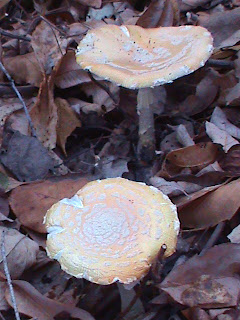Written by Laura
It's fall, and what better to do than to take a walk in the woods. I set out with my two daughters on a little family adventure. We live about 20 miles northwest of the FFP farm. Our primary goal was to find some edible mushrooms. I decided to search a near by woods where, earlier in the year, I had found many hedgehog mushrooms. We did find some fungi, but nothing I was willing to put on our dinner plates.
Turkey tail was our primary find, as usual. Although nonedible (its leathery texture would certainly cause a stomach ache) and nonpoisonous, this mushroom is highly medicinal. We also came across Amanita muscaria, a highly toxic, but beautiful mushroom. Puffballs (Lycoperdon pyriforme) on a log turned out to be the highlight of the day for the girls. What kid doesn't love smashing these little things? I'm not gong to lie, I even like doing it. The puffballs are edible, but not when they have turned brown and produced spores. You have to find these things when they are still pure white inside and out. The giant puffball (Calvatia gigantea) would probably be more worth your time though. Beware, never mistake a young Amanita for a puffball!
 |
| Amanita muscaria, should never be eaten. |
 |
| After taking this picture all of these puffballs were squished. |
 |
| What a great fall background! |
 |
| This flush of Chicken of the Woods, Laetiporus sulphureus, was found in the early summer. |
 |
| Hericium coralloides growing on an old maple log in the woods next to my house. |
 |
| The same log, Hericium higher up from the ground was pink in color (not uncommon). |
 |
| Reishi, Ganoderma tsugae, can be seen from my living room window growing on hemlock stumps and downed logs. |
 |
| Shaggy Manes are no stranger to my yard this time of year. |
 |
| A pile of maple and beech logs which were supposed to be cut for fire wood have become one of my favorite mushroom hunting grounds. Oysters primarily grow here. |
 |
| Mary Ellen holding a wild Maitake. |
 |
| Caution should be taken when trying to identify the Wood Blewit. |

Anyone know if there is information on or has experience in consistent consumption of Ganoderma Tsugae? I have experience with G. Lucidum in TCM and there is a species which grow on Tamarack-type trees that is ingested in China as well. I was wondering if it could be the same for G. Tsugae on hemlocks with no ill effect.
ReplyDeleteGreg A. Marley wrote a book called "Mushrooms for Health." In it he includes a section on Reishi which talks about both G. lucidium and G. Tsugae. While he differentiates between the two when it comes to habitat and ecology, he chose to lump them together as one for their medicinal use. He states that recent studies show that "the section of genus Ganoderma that contains both these species is now recognized as a complex of closely related and difficult-to-distinguish species." I suggest reading his book. It will not only answer more questions on these two species, but many other highly medicinal mushrooms.
ReplyDeleteIt sounds like your mushroom-hunting expedition was a roaring success! I’m sure your girls will come to love it as much as you do with time. It’s cool how much you know about mushrooms already. But, I think you were right to bring along friends who are knowledgeable on mushroom identity and toxicity. You just never know what could happen if you pick up the wrong mushroom!
ReplyDelete-- Mack Shepperson
ReplyDeleteHello,
If you want to go into mushroom farming business, There are so many company website this days like http://www.virtatrade.com that will enable you as a beginner to raise the fund you need to start up your mushroom farming business without you seeking for a loan.
This company is where many business dealers from all over the world generate fund that backup their various businesses financially.
I used this company to backup my cocoa beans export business each time my business is running down.
You can visit and register with the company website here http://www.virtatrade.com to raise the fund you need now to go into your mushroom farming business.